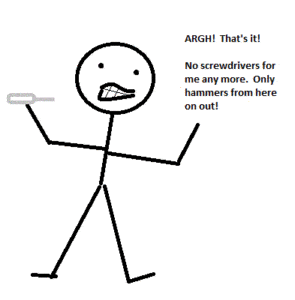You can’t get through a week these days without reading about another high-profile, progressive, cooler-than-teal business eliminating performance reviews. So provocative!
The story goes like this: Do you hate those horrible, lengthy, largely irrelevant standardized performance review forms your HR department forces on you? The solution is simple. Get RID of them. Throw babie out with bath water! Be penny wise and pound foolish! Overuse tropes for questionable effect!
The truth is that people gain from written, sincere role-related feedback.
Other things are distractions—things like numerical scores, forced rankings, comp negotiations, and ratings on stuff irrelevant to the role. These things distract both the manager and employee from the performance-enhancing parts of the developmental conversation. These things feel like busy-work at best and something to protect your team against at worst. Never mind the machinations, groveling, and cage fight matches that go into securing reasonable, performance review-related compensation changes.
What a disaster! We plead to all that’s holy, we have to fix this. Even if it means throwing the whole process out the window.
What’s going on here? How DO we fix this?
We’ve all heard stories about how performance feedback goes terribly wrong. It does seem the process itself is fundamentally flawed. We can’t always put our finger on why, but gosh-darnit, when something is fundamentally flawed, then we ought to toss it out like last week’s trash. Right? Maybe, just maybe, we humans have simply evolved past the utility of these archaic tools.
Superior self-congratulations aside, it’s not unheard of for humans to outgrow things. We don’t use ‘time outs’ with 20 year olds, do we? That disciplinary practice is designed for younger children. Likewise, perhaps we adults have outgrown these old-school performance reviews. It could happen!
But that’s not what I see going on.
It’s quite a misnomer, calling the problem “performance reviews”. It leads you to think the process is designed, first and foremost, to provide the people being reviewed useful feedback about their performance. Yet, none of the actual problems with performance reviews has anything to do with reviewing performance.
The pain comes from all the other things we bundle into performance reviews.
The pain comes from the linkage to pay decisions, especially the narrowly bounded, zero-sum game that most managers go through with compensation decisions for their teams. The pain comes from an over-emphasis on providing the details that reduce legal risk and ensure compliance with various laws and hypothetical dooms day scenarios. The pain comes from the laundry list of company-wide competencies that feel neither relevant nor particularly important for helping your team member perform her role well. All this hoop-jumping does NOT help people perform better.
Isn’t a performance review actually intended to improve performance? Not just each individual’s performance, but also your whole team’s performance. Because team performance is what expands your business’ ability to create value. Because team performance and value creation grows your business.
Feedback processes that create business value — how do we get from here to there?
To help us make sense of the disconnect we feel between traditional (read: sadly broken) performance feedback and useful feedback, I’m going to borrow some language about assessments from the education field. After all, a performance review is a form of assessment.
In education-speak, there are two types of assessments instructors use with students and they are called formative and summative.
Formative Assessment |
Summative Assessment |
| The goal of formative assessment is to monitor student learning to provide ongoing feedback that can be used by instructors to improve their teaching and by students to improve their learning. | The goal of summative assessment is to evaluate student learning at the end of an instructional unit by comparing it against some standard or benchmark. |
Source: http://www.cmu.edu/teaching/assessment/basics/formative-summative.html
Sure, the terminology sounds hinky and academic. Don’t let that turn you off, because those education folks know some things that those of us on the business side have been missing. In this case, educators know that there are two very different sorts of assessments that lead to distinct types of beneficial outcomes. One is developmental (formative) and the other is evaluative (summative). Educators know to use the right tool for each job.
What can we, in the business world, learn from educators?
There are two very different sorts of outcomes any performance assessment system provides a business. One is developmental (formative) and the other is evaluative (summative). When we design an evaluation-oriented performance review program, we ought not be so surprised, nay horrified when it offers poor-to-non-existent developmental benefits. It’s like grabbing the Phillips head screw driver to use on a flat-head screw and getting pissed off at the tool for not working right.
About providing developmental feedback.
We know it’s important to do this well. And we know there are certain people who think really often and deeply about this sort of thing and who have their opinions published in writing. We usually call these people experts. It so happens that these experts don’t all agree on the always-bestest way to provide formative performance feedback. Not even the education experts can agree. Why is that? That’s likely because the context matters a whole lot when figuring out what works best in any situation with any particular person.
Managers have that context. Yes, yes you do.
Lets assume you’re a manager. You manage people. Did you know that you are responsible for the performance of those people? That’s right. It is your job to provide your team with the resources and information they need to do their best work to accomplish the result you are accountable for. Guess what? One of those resources is your time and attention. And even more relevant, some of that information is formative feedback.
Let me say that again. If you are a manager, it is your job to provide formative feedback. With each and every person on your team and as often as it takes. How you go about it may vary with each individual on your team. Your methods may also evolve with changing priorities. This is the work of management. And, yeah, it’s hard to do well.
Some of you may be gifted with the intuition on how to do formative feedback exceptionally well. For others, it’s a little tougher row to hoe. If, after getting plenty of guidance and training from people who are really good at this kind of thing, you still just can’t figure it out, well, then you might be in the wrong role. But, theoretically, you should know that already because your manager is responsible for your performance and will be providing you the right formative feedback to help you succeed. It’s a sad state of affairs that everyone reading this knows that things don’t frequently go that way. I’ll save that diatribe for another post.
On performance evaluation and benchmarks.
Evaluative (summative) assessments, as you recall, provide measures of performance against a standard. Evaluative assessments have their purpose in both education and the business world. In business, it can be useful to have calibrated evaluations to help make equitable compensation decisions, measure promotion readiness, and evaluate whether a team member is meeting the bar for staying with the company. Standards create guardrails around what the business values, encourages, and tolerates in people performance. Measuring against these standards, well, that’s a good thing.
But why can’t we do both things in the same assessment?
On the surface, it seems that one-evaluation-for-all-things would be more efficient. You know we LOVE efficiency in business!
But nope.
Some things that are necessary for evaluation are real distractions for developmental feedback. Common distractions include numerical scores, salary impacts of numerical scores, and ratings on non-critical-for-performance laundry lists of things. These are examples and not a comprehensive list, but the point is this. If you try to do two disparate things in one process that don’t play well together, you will do both things poorly. Or, in the very least, you’ll make it necessary for your managers to work extra hard to do both things well despite the restrictions of that “efficient” process.
That, my friend, is bad design. Don’t fall prey to bad design.
If you create a system that makes it likely to do important things poorly, you are sacrificing potential business value. Every day. And that would be sad.
Do you want the people working at your business fully equipped to perform at a high level?
Do you want the people working at your business continuously improving their performance?
Do you want the people working at your business content with the fairness of your people systems so they can focus on doing good work?
If you answer YES to all three questions, then you should have BOTH formative and summative evaluation working well. Systems drive behaviors. If you want to encourage your leaders to do BOTH developmental and evaluative assessments at high quality, you should design systems that encourage that to happen.
We now know that both developmental and evaluative assessment are necessary for business. We now know that doing both within the same process sacrifices the effectiveness of both aims.
Consider having separate performance review systems, one that optimizes development and one that optimizes evaluation.
It’s likely you’ll be able to make each tool far, far simpler because it will be focused. Two really simple assessment methods are, counter-intuitively, far more efficient than one complicated method that doesn’t really do either thing very well. In the very least, the former option can avoid the sheen of pointlessness that most current performance review systems suffer from.
The hippest trends in performance feedback.
The internet is filled with the latest old-is-new-again, data-based, and tech-enabled feedback practices. There’s good. There’s bad. And there’s ugly. For every shiny-happy-people-loving upside you read, there lurks, in the shadows, hidden trade-offs.
Whether it’s extreme transparency of data-based results, a shift to peer feedback in place of or supplemental to managerial feedback, or transitioning to frequent verbal check-ins in place of annual reviews. Or the 100s of other ideas bubbling up every day. Covering each one in detail is beyond the scope of this article, but please contact me if you have questions about specific innovations you’d like me to write more about.
Customize performance feedback for your business.
What works one place might not work great somewhere else. Context matters. Context like your culture, your industry, and your operating model.
I’m not going to give you a formula for how to do each kind of performance assessment at your business. I believe that best practices are customized practices and I’m pretty sure you have lots of smart, capable people at your business that can create something great.
Here are some tips. Contact me to talk about things in more detail.
Tips for Effective Formative Feedback
- You are accountable for their success
- Timely and prompt feedback
- Clearly define desired work outputs
- Provide context and purpose
- Opportunity for dialogue
- Removal of distractions
- Leverage and emphasize strength
- Focus on what’s most relevant


